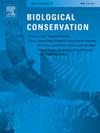花卉颜色多样性的下降改变了蜜蜂在碎片化栖息地的颜色偏好
IF 4.9
1区 环境科学与生态学
Q1 BIODIVERSITY CONSERVATION
引用次数: 0
摘要
栖息地破碎化降低了植物群落花的颜色多样性,从而导致蜜蜂传粉媒介对颜色的偏好发生变化,这表现在访问频率的改变上。本文对中国东部一个水库岛屿系统的41个岛屿及其邻近大陆生境进行了为期两年的植物-蜜蜂相互作用调查。结果表明,蜂蓝绿和蜂蓝在花色组成中占主导地位,岛屿面积的减少显著降低了花色多样性。随着岛屿面积的减少,蜜蜂蓝绿花、蜜蜂紫外蓝花和蜜蜂紫外绿花的访花频率显著下降。花朵颜色多样性的变化改变了蜜蜂的颜色偏好,并显著影响了总访花频率。随着岛屿面积的增加,蜜蜂对蓝绿色花的偏好增加,而花卉资源对访花频率的影响不显著。总之,这些结果提高了我们对传粉者如何在破碎生境中适应其行为的理解,并为保护花的颜色多样性以及与高访问频率对应的颜色相关的植物物种提供了重要的见解。本文章由计算机程序翻译,如有差异,请以英文原文为准。
Declining floral color diversity alters bee color preferences in fragmented habitats
Habitat fragmentation reduces floral color diversity in plant communities, thus resulting in a shift in bee pollinator color preferences, as shown by altered visitation frequency. We conducted a two-year survey of plant-bee interactions on 41 islands and adjacent mainland habitats in a reservoir island system of eastern China. Results showed that bee-blue-green and bee-blue dominated the floral color composition and that a reduction in island area significantly reduced floral color diversity. Visitation frequencies to bee-blue-green, bee-ultraviolet-blue, and bee-ultraviolet-green flowers declined significantly as island area decreased. These changes in floral color diversity altered the color preferences of bees, as shown by the significantly impacted total floral visitation frequencies. The preference for bee-blue-green flowers increased as island area increased, while floral resources showed no significant effect on visitation frequencies. In sum, these results improve our understanding of how pollinators adapt their behavior in fragmented habitats and provide important insights supporting the conservation of floral color diversity as well as the plant species associated with the colors that correspond to a high visitation frequency.
求助全文
通过发布文献求助,成功后即可免费获取论文全文。
去求助
来源期刊

Biological Conservation
环境科学-环境科学
CiteScore
10.20
自引率
3.40%
发文量
295
审稿时长
61 days
期刊介绍:
Biological Conservation is an international leading journal in the discipline of conservation biology. The journal publishes articles spanning a diverse range of fields that contribute to the biological, sociological, and economic dimensions of conservation and natural resource management. The primary aim of Biological Conservation is the publication of high-quality papers that advance the science and practice of conservation, or which demonstrate the application of conservation principles for natural resource management and policy. Therefore it will be of interest to a broad international readership.
 求助内容:
求助内容: 应助结果提醒方式:
应助结果提醒方式:


